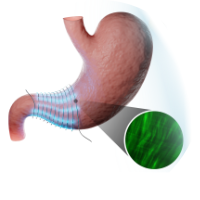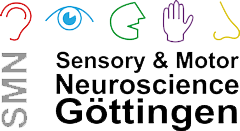Team III
Optogenetic Gastric Pacemaking
We have pioneered direct optogenetic stimulation of striated and smooth muscle cells which, in contrast to electrical prosthetics, promises sustained control of muscle function independent of the status of the innervating nerves. Gastroparesis is a burdensome disease with millions of patients affected without any appropriate treatment option. It entails a loss of food propulsion from the stomach into the intestine without physical obstruction and, in most cases, is caused by malfunctioning of the enteric nervous system and interstitial cells of Cajal while the smooth muscle cells typically remain intact. Treatment by electrical stimulation, however, is only tolerable for patients at low energies which suffice stimulation of the afferent nerves but not smooth muscle cells and can thus not induce contractions and restore motility. First clinical studies reported mild relief of symptoms in some cases but never a restoration of food propulsion. We have proven that direct optogenetic stimulation of smooth muscle cells induces force generation increasing intragastric pressure and ultimately food propulsion in the stomach of transgenic mice expressing ChR2 (https://www.thno.org/v11p5569.htm). Importantly, ChR2 expression in one third of the smooth muscle cells was sufficient to generate as much force as potassium depolarization of all cells and significantly more force when compared to electrical stimulation. Recently, we have characterized a human receptor Neuroopsin (hOPN5) and proven that its optical activation selectively drives Gq protein signaling and consequently triggers Ca2+ transients in smooth muscle cells (https://www.nature.com/articles/s41467-022-29265-w). In this project, we will first inevstigate the different mechanisms and compare the efficiencies of these two completely separate and complementary approaches: Light induced membrane depolarization and generation of actions potentials with light-induced Gq signaling with the advantage of intracellular signal amplification. We will then explore improved variants of channelrhodopsins including ChReef and OPN5 mutants. The next steps are to find an efficient gene transfer, test the approach in vivo in healthy and gastroparetic animals and develop medical devices for efficient illumination.








